Pizza is a beloved and popular food, but have you ever wondered how many calories are in 3 slices of this delicious treat? When it comes to maintaining a balanced diet, understanding the nutritional content of the foods we love is key. In this article, we will dive into the world of pizza calories and explore the factors that can affect the calorie count of your favorite slices.
- The calorie content of 3 slices of pizza can vary depending on factors such as size, toppings, and brand.
- On average, a small cheese pizza slice can contain around 300 calories, while a large meat-lovers pizza slice may have up to 500 calories.
- Vegetable toppings generally have fewer calories compared to higher fat meats like sausage and pepperoni.
- The type of sauce used on pizza can also impact the calorie count, with marinara sauce having lower calories compared to Alfredo, BBQ, or white sauce.
- Different pizza brands can vary in calorie content, so it’s important to check the nutritional information provided by popular chains.
Understanding the calorie content of pizza and making informed choices can help you enjoy this classic dish while still maintaining a healthy diet. In the following sections, we will delve deeper into the factors that can influence pizza calorie count, explore the calorie range for different types of pizza, and provide helpful tips and alternatives for making pizza a healthier choice.
Factors Affecting Pizza Calorie Count
The number of calories in 3 slices of pizza can vary based on several factors that affect its calorie content. Size, type, toppings, and sauce all play a role in determining the calorie count of your favorite slice. Let’s take a closer look at these factors:
Size:
The size of the pizza slice can significantly impact its calorie content. Generally, larger slices contain more calories compared to smaller ones. It’s essential to be mindful of portion sizes when enjoying your pizza to manage your calorie intake.
Type:
Different types of pizza, such as cheese, pepperoni, or meat-lovers, have varying calorie counts. Cheese pizzas tend to have fewer calories compared to meat pizzas due to the absence of high-fat meats like sausage or pepperoni. Opting for a cheese pizza can be a lighter choice if you’re watching your calorie intake.
Toppings:
The toppings you choose can significantly impact the calorie count of your pizza. Vegetables, such as mushrooms, onions, and bell peppers, add flavor and nutrients without adding many calories. On the other hand, high-fat toppings like sausage and pepperoni can increase the calorie content. Consider opting for healthier toppings to keep your pizza lower in calories.
Sauce:
The type of sauce used also affects the calorie count of your pizza. Lighter sauces like marinara have fewer calories compared to cream-based sauces like Alfredo. Choosing a pizza with lighter sauce options can help keep your calorie intake in check.
By considering these factors, you can make more informed choices when it comes to enjoying pizza without compromising your diet goals. Remember, portion control and moderation are key to incorporating pizza into a balanced diet.
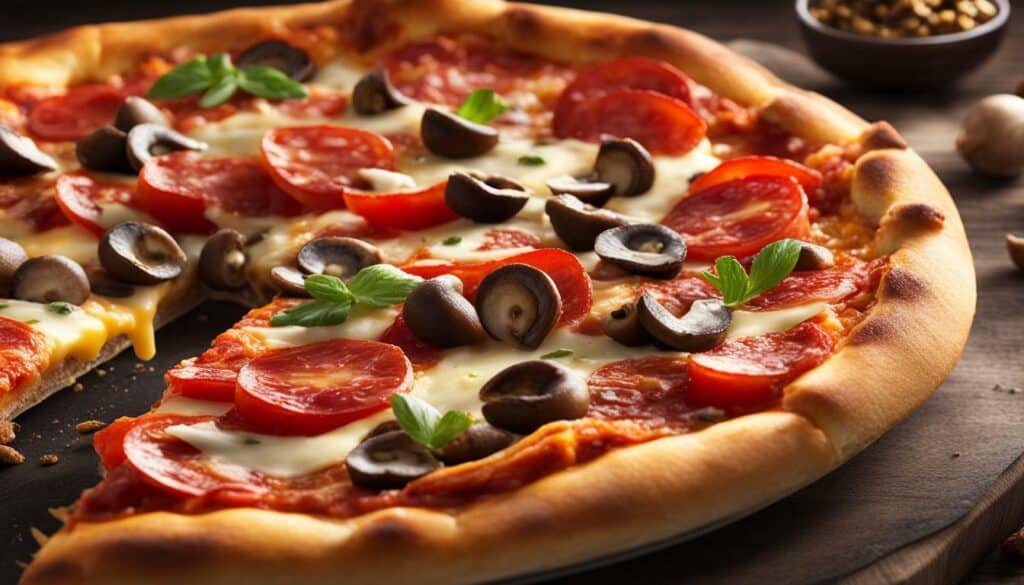
| Pizza Brand | Calories (3 Slices) |
|---|---|
| Domino’s Pizza | 470 – 550 |
| Papa John’s Pizza | 450 – 600 |
| Pizza Hut | 500 – 650 |
| Little Caesars Pizza | 400 – 550 |
Calorie Range for Cheese Pizza
When it comes to cheese pizza, the calorie count for 3 slices can range depending on the size and brand. The number of calories in 3 slices of cheese pizza can vary between 450 and 520 calories. This range takes into account different sizes and brands of cheese pizza. Larger slices or slices from certain brands may have a higher calorie count, while smaller slices or slices from other brands may have a lower calorie count.
To give you a better idea of the calorie range for 3 slices of cheese pizza, here is a table comparing the calorie content for different sizes and brands:
| Size | Brand | Calories per 3 slices |
|---|---|---|
| 12 inch | Brand A | 450 |
| 14 inch | Brand B | 480 |
| 16 inch | Brand C | 520 |
As you can see, the calorie count can vary depending on the size and brand of cheese pizza. It’s important to check the nutrition information provided by the specific brand or restaurant you are ordering from to get an accurate estimate of the calorie content.
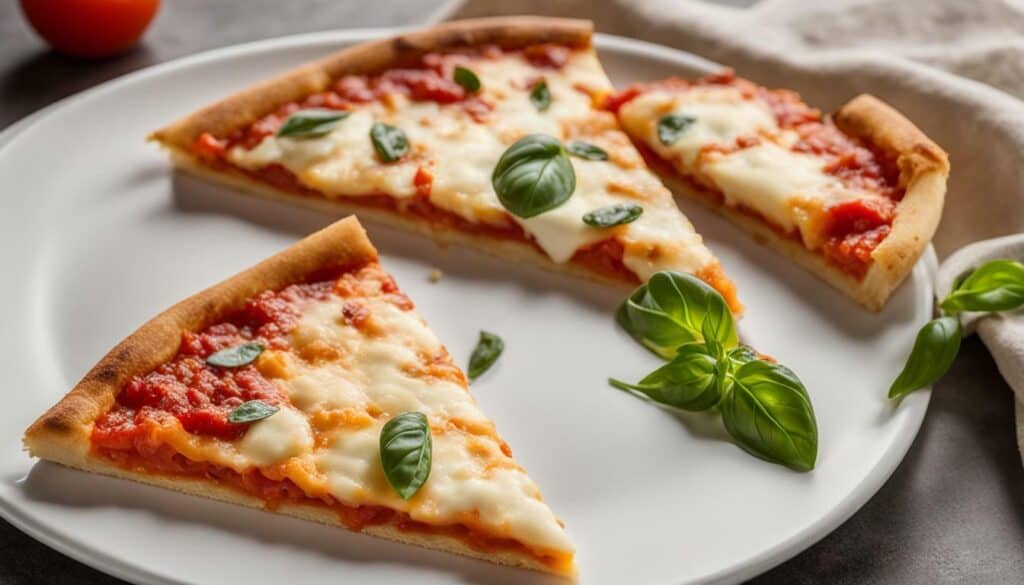
Calorie Range for Pepperoni Pizza
Pepperoni lovers will want to know the calorie count for 3 slices of this classic pizza flavor. The calorie range can vary depending on the size and brand of the pizza. On average, 3 slices of pepperoni pizza can range from 520 to 650 calories.
When it comes to pizza, the size of the slice and the amount of toppings can greatly impact the calorie count. A larger slice will naturally have more calories compared to a smaller slice. Additionally, toppings like pepperoni, which are higher in fat, can contribute to a higher calorie count. It’s important to keep these factors in mind when indulging in your favorite pizza.
To give you a better idea, here is a table showcasing the calorie range for 3 slices of pepperoni pizza from popular brands:
| Brand | Calories (3 Slices) |
|---|---|
| Domino’s Pizza | 520 – 600 |
| Papa John’s Pizza | 570 – 650 |
| Pizza Hut | 600 – 680 |
| Little Caesars Pizza | 550 – 630 |
Keep in mind that these values are estimates and may vary slightly depending on specific ingredients and portion sizes.
If you’re looking to make your pizza experience healthier, you can opt for a thin crust to reduce calorie intake. You can also try adding more vegetable toppings like bell peppers, onions, and mushrooms, which are lower in calories compared to meats and cheeses. Moderation is key, so enjoy your pizza in moderation and balance it with a well-rounded diet.
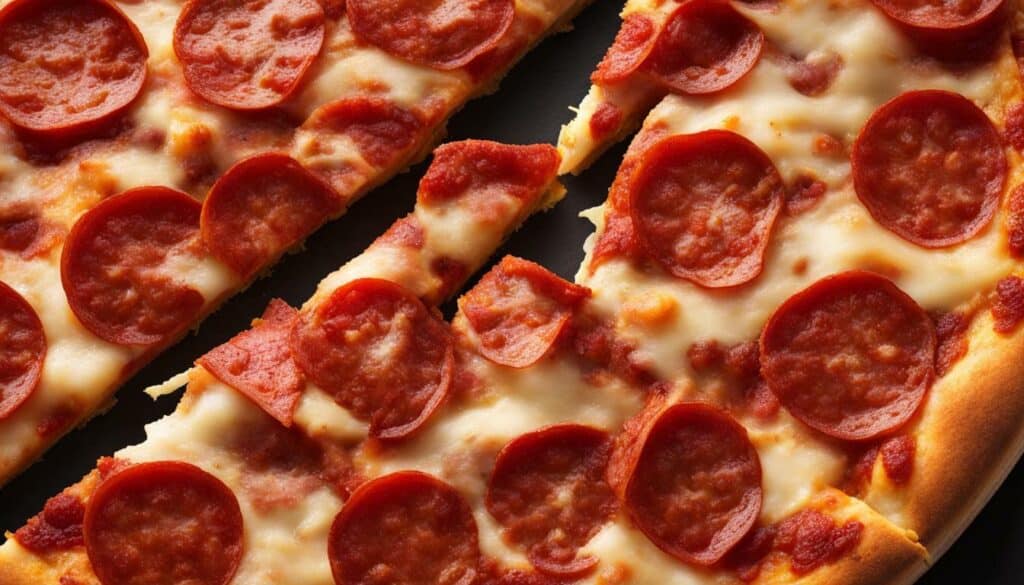
The toppings you choose can significantly impact the calorie content of your pizza slices. When it comes to keeping your pizza on the healthier side, opting for vegetable toppings can add flavor and nutrition while keeping the calorie count lower. For example, adding vegetables like mushrooms, onions, bell peppers, and spinach can provide extra vitamins and fiber without adding excessive calories.
On the other hand, higher-fat meats like sausage and pepperoni can contribute to a higher calorie count. These toppings not only add extra calories but also increase the saturated fat content of your pizza. It’s essential to keep in mind that moderation is key, and choosing leaner protein options like grilled chicken or turkey can be a healthier alternative.
Another factor to consider is the cheese. While cheese is a classic and delicious pizza topping, it can also be a significant source of calories. To reduce the calorie content, you can opt for reduced-fat or part-skim cheese options. Additionally, using less cheese or opting for a combination of cheese and other toppings, like vegetables or lean protein, can help keep the calorie count in check.
Table: Calorie Content of Common Pizza Toppings
| Topping | Calories per serving |
|---|---|
| Mushrooms | 10 |
| Onions | 10 |
| Bell Peppers | 20 |
| Spinach | 5 |
| Sausage | 160 |
| Pepperoni | 140 |
| Grilled Chicken | 120 |
| Reduced-Fat Cheese | 80 |
By being mindful of the toppings you choose, you can create a pizza that satisfies your cravings while also aligning with your health goals. Remember, portion control is essential, and it’s always a good idea to balance your pizza with plenty of vegetables and other nutritious foods throughout the day.
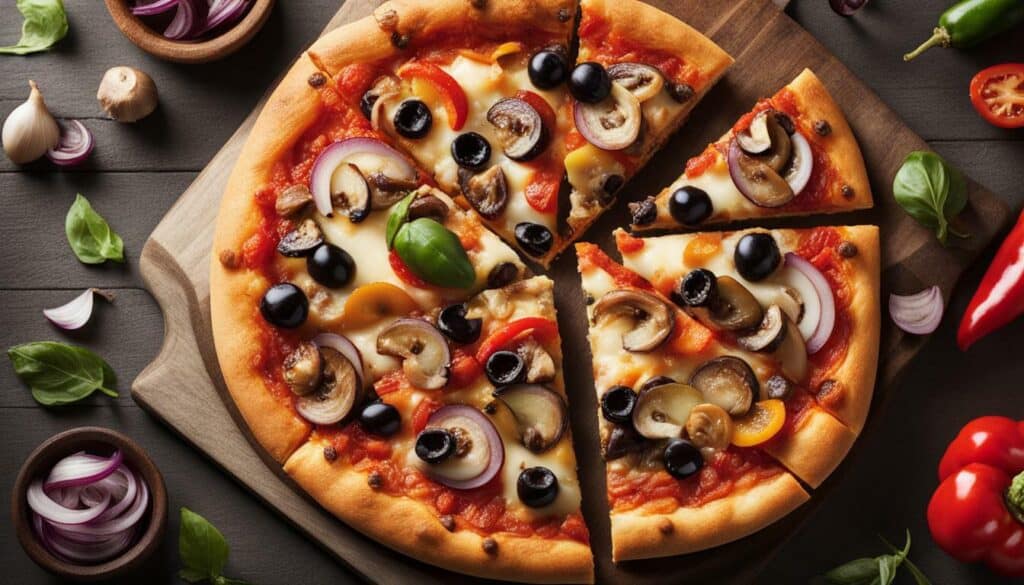
The sauce used can be a hidden source of calories in your pizza slices. While it may seem like a small component, the choice of sauce can significantly impact the overall calorie count of your favorite pie. Let’s take a closer look at how different sauce options can affect the calorie content.
Traditional marinara sauce is usually the go-to choice for pizza lovers. Not only does it add flavor, but it also tends to have lower calories compared to other sauce options. On average, a quarter cup of marinara sauce contains around 60 calories.
However, if you prefer a creamier and richer taste, sauces like Alfredo, BBQ, or white sauce may be your top picks. While these sauces can be delicious additions to your pizza, they also tend to be higher in calories. A quarter cup of Alfredo sauce, for example, can contain around 150 calories.
When it comes to watching your calorie intake, it’s important to be mindful of the sauce you choose. Opting for lighter options like marinara sauce or using them in moderation can help you enjoy your favorite pizza while keeping your calorie count in check.

| Sauce Type | Calories per Quarter Cup |
|---|---|
| Marinara | 60 |
| Alfredo | 150 |
| BBQ | 100 |
| White Sauce | 120 |
Table: Calories per Quarter Cup of Different Pizza Sauces
Calorie Comparison Across Pizza Brands
Calorie counts can vary across different pizza brands, so it’s important to know the differences. When it comes to enjoying a delicious slice of pizza, understanding the calorie content can help you make informed choices that align with your dietary goals.
To provide a comparison, here are the estimated calorie ranges for 3 slices of a 14-inch pizza from popular chains:
| Brand | Calories |
|---|---|
| Domino’s Pizza | 470-550 |
| Papa John’s Pizza | 450-600 |
| Pizza Hut | 500-650 |
| Little Caesars Pizza | 400-550 |
These calorie ranges highlight the variation in pizza brands, emphasizing the need to make choices that align with your dietary needs. It’s worth noting that these calorie ranges are approximate and can differ based on factors such as toppings and crust thickness.
When enjoying pizza from your favorite chain, it may be helpful to refer to the nutritional information provided by the brand to get a more accurate understanding of the calorie content. This way, you can make choices that support your dietary goals and preferences.
Remember, while understanding the calorie content of pizza is important, it’s also essential to consider portion control and moderation. Pizza can be part of a balanced diet when enjoyed in moderation and paired with nutrient-rich sides such as salads or vegetables.
By staying informed about the calorie content of different pizza brands and making mindful choices, you can indulge in your favorite slices while still maintaining a healthy lifestyle. Enjoy your pizza with confidence knowing that you’ve made choices that align with your nutritional goals.
Making Pizza a Healthier Choice
Pizza can be enjoyed as part of a healthy diet by making a few modifications. By choosing the right ingredients and practicing portion control, you can indulge in your favorite treat without compromising your nutrition goals.
1. Opt for Thin Crust
When selecting your pizza crust, opt for thin crust over thicker options. Thin crust pizza tends to have fewer calories because it contains less dough. This means you can enjoy your favorite flavors without consuming excessive amounts of carbohydrates and calories.
2. Load Up on Vegetable Toppings
One way to make your pizza healthier and more nutritious is to load it up with a variety of vegetable toppings. Vegetables like bell peppers, onions, spinach, and mushrooms are not only low in calories but also packed with essential vitamins, minerals, and fiber. They add flavor, texture, and color to your pizza without adding significant calories.
3. Use Less Cheese
Cheese is undoubtedly delicious, but it can also contribute to the calorie content of your pizza. To make your pizza healthier, try using less cheese or opting for lower-fat alternatives. You can still enjoy the gooey goodness of melted cheese by using part-skim mozzarella or choosing a blend of different cheeses with stronger flavors, so you need less to satisfy your taste buds.
To summarize, making pizza a healthier choice is all about making smart ingredient choices and practicing portion control. Opt for thin crust, load up on nutritious vegetable toppings, and use less cheese. By making these modifications, you can still enjoy the mouthwatering flavors of pizza while maintaining a balanced and nutritious diet.
| Brand | Calories (3 Slices) |
|---|---|
| Domino’s Pizza | 470-550 |
| Papa John’s Pizza | 450-600 |
| Pizza Hut | 500-650 |
| Little Caesars Pizza | 400-550 |
Understanding the calorie content of pizza and making informed choices can help you manage your weight and maintain a healthy diet. Remember to enjoy pizza in moderation and balance it with other nutritious foods. By making small modifications, you can savor your favorite slices guilt-free while meeting your nutritional needs.
Healthy Alternatives to Traditional Pizza
If you’re looking for a healthier twist on pizza, there are plenty of delicious options to try. These alternatives not only offer a lower calorie count but also provide additional nutrients and flavors that can satisfy your cravings. Let’s explore some mouthwatering options:
Stuffed Portobello Mushrooms
Instead of a traditional pizza crust, try using large portobello mushroom caps as your base. These dense and meaty mushrooms offer a satisfying texture and can be filled with a variety of toppings. Layer on some tomato sauce, low-fat cheese, and your favorite vegetables for a nutritious and tasty alternative.
Pita Pizza
Swap out the regular pizza dough for whole wheat or gluten-free pita bread. These smaller-sized rounds make for a crispy crust and are a perfect individual portion. Top with marinara sauce, lean protein such as grilled chicken or turkey, and a colorful array of veggies like bell peppers, spinach, and onions. Finish with a sprinkle of reduced-fat cheese for added flavor.
Veggie Pizza
This option allows you to load up on the goodness of vegetables. Choose a cauliflower or broccoli crust for a low-carb alternative or go for a whole wheat crust for added fiber. Layer on an assortment of colorful veggies such as sliced tomatoes, zucchini, mushrooms, and artichoke hearts. Add a drizzle of olive oil and a sprinkle of herbs and spices to enhance the flavors.
Flatbread Pizza
Flatbread pizzas offer a thin and crispy base that is lower in calories compared to traditional pizza dough. Use whole grain or multigrain flatbread and top it with your preferred sauce, whether it be tomato, pesto, or even hummus. Add a generous amount of vegetables, some lean protein like grilled shrimp or tofu, and a sprinkle of reduced-fat cheese for a satisfying meal.
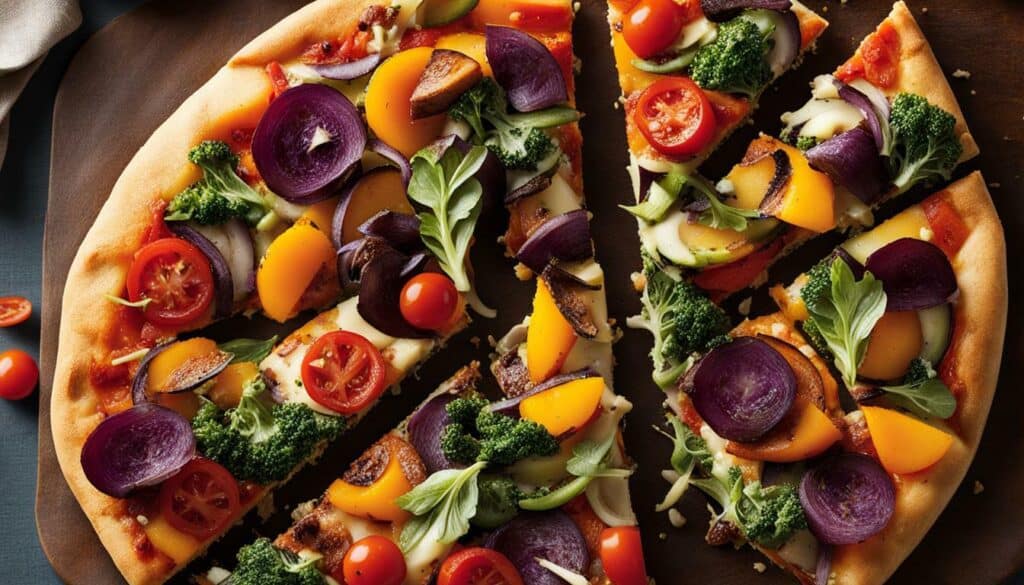
When it comes to pizza, creativity knows no bounds. Feel free to experiment with different ingredients and flavors to find the healthy alternative that suits your palate. Remember, portion control is still important, even with these healthier options. Enjoy your pizza in moderation as part of a balanced diet and savor every bite!
| Pizza Alternative | Calories per Serving | Nutrition Info |
|---|---|---|
| Stuffed Portobello Mushrooms | 150 calories | Low in fat, high in fiber and antioxidants |
| Pita Pizza | 220 calories | Good source of protein and whole grains |
| Veggie Pizza | 180 calories | Packed with vitamins, minerals, and dietary fiber |
| Flatbread Pizza | 200 calories | Lower in carbs and fat compared to traditional pizza |
Conclusion
Understanding the calorie content of pizza can help you make informed choices and maintain a healthy diet while still enjoying this beloved food. When it comes to decoding your diet and determining how many calories are in 3 slices of pizza, several factors come into play. The type of pizza, toppings, and brand all contribute to the overall calorie count.
On average, a small cheese pizza slice contains around 300 calories, while a large meat-lovers pizza slice may have up to 500 calories. However, the specific calorie range for 3 slices of pizza can vary. For example, 3 slices of cheese pizza can range from 450 to 520 calories, while 3 slices of pepperoni pizza may range from 520 to 650 calories.
The choice of toppings can also impact calorie content. Vegetables and pineapple generally have fewer calories, while higher fat meats like sausage and pepperoni can increase the calorie count. Additionally, the type of sauce used on the pizza can make a difference. Marinara sauce tends to have lower calories compared to Alfredo, BBQ, or white sauce.
It’s worth noting that different pizza brands can have varying calorie content. For example, estimates for 3 slices of a 14-inch pizza from popular chains range from 470 to 550 calories for Domino’s Pizza, 450 to 600 calories for Papa John’s Pizza, 500 to 650 calories for Pizza Hut, and 400 to 550 calories for Little Caesars Pizza.
To make pizza a healthier choice, consider opting for thin crust for fewer calories, adding more vegetable toppings, and using less cheese. If you’re looking for alternatives to traditional pizza, there are plenty of healthier options to explore, such as stuffed portobello mushrooms, pita pizza, veggie pizza, flatbread pizza, individual egg white pizzas, and zoodle pizza bake. Remember, portion control and moderation are key even when enjoying pizza as part of a balanced diet.
By understanding the calorie content of pizza and making informed choices, you can still indulge in this delicious food while maintaining a healthy lifestyle. So go ahead and enjoy your pizza, but remember to keep an eye on those calories!
FAQ
Q: How many calories are in 3 slices of pizza?
A: The number of calories in 3 slices of pizza depends on the type, size, and toppings. On average, 3 slices of cheese pizza can range from 450 to 520 calories, while 3 slices of pepperoni pizza may range from 520 to 650 calories.
Q: What factors affect the calorie count of pizza?
A: The calorie count of pizza can be influenced by factors such as the size, type, toppings, and sauce. Thin crust options generally have fewer calories compared to thick crust, and vegetable toppings tend to have fewer calories than high-fat meats like sausage and pepperoni.
Q: How does the type of sauce impact the calorie content of pizza?
A: The type of sauce used on pizza can impact its calorie content. Marinara sauce typically has lower calories compared to Alfredo, BBQ, or white sauce.
Q: Which pizza brands have different calorie ranges for 3 slices?
A: Different pizza brands can vary in calorie content. For 3 slices of a 14-inch pizza, estimates range from 470 to 550 calories for Domino’s Pizza, 450 to 600 calories for Papa John’s Pizza, 500 to 650 calories for Pizza Hut, and 400 to 550 calories for Little Caesars Pizza.
Q: How can I make pizza a healthier choice?
A: To make pizza a healthier choice, you can opt for thin crust for fewer calories, choose more vegetable toppings, and use less cheese. Portobello mushrooms, pita bread, and zucchini noodles can also be used as alternatives to traditional pizza crust.
Q: Are there healthier alternatives to traditional pizza?
A: Yes, there are healthier alternatives to traditional pizza. Some examples include stuffed portobello mushrooms, pita pizza, veggie pizza, flatbread pizza, individual egg white pizzas, and zoodle pizza bake.
How Many Calories are in 1 Slice of Sliced Pepperoni?
When it comes to the sliced pepperoni calorie breakdown, one slice typically contains around 50-60 calories. This popular cured meat adds a flavorful punch to pizzas, sandwiches, or even salads. However, moderation is key, as consuming too many slices of pepperoni can quickly increase the calorie count of your meal.

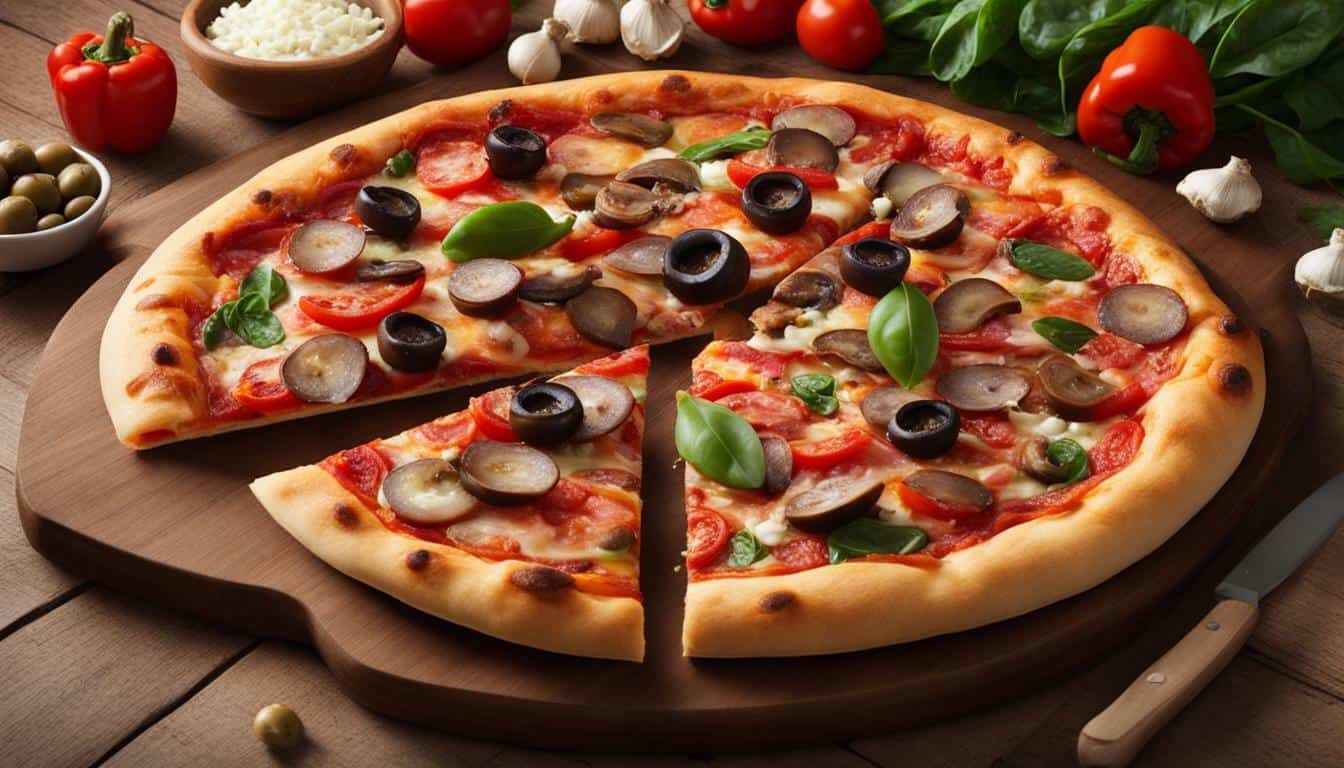



Leave a Reply